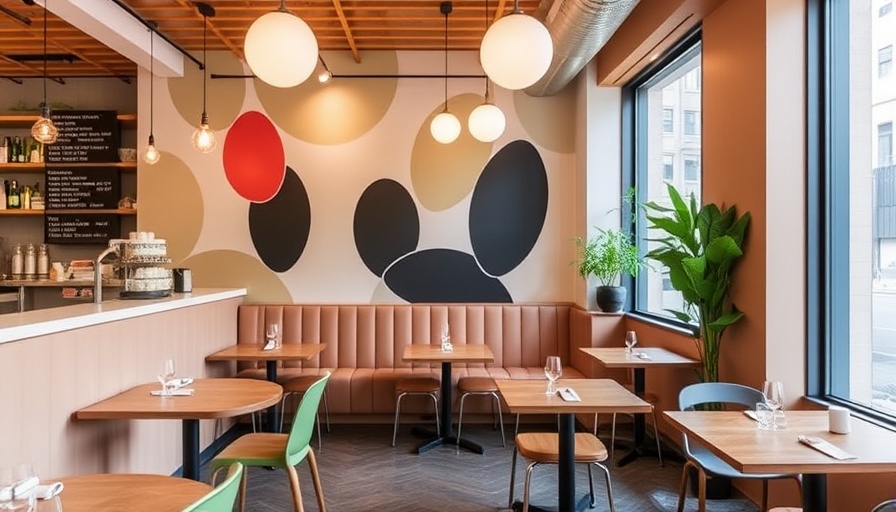
Unwind and Recharge: A Collection of Design-Oriented Cafes
As the NYCxDesign festival unfolds, the bustling streets of New York offer a perfect mix of art, architecture, and, most importantly for remote workers, exceptional spaces to relax and recharge between events. For digital nomads navigating the hectic programming of this vibrant week, find solace in these twelve stunning cafes and restaurants. Each location not only serves as a backdrop for creativity but also aligns seamlessly with ergonomic principles that enhance productivity and comfort.
- Printemps: Where Elegance Meets Efficiency
Located in the historic One Wall Street skyscraper, Printemps features inspiring architectural elements and provides an inviting space for those looking to catch their breath during the festival. The varied seating options and a beautifully designed café make it ideal for casual meet-ups or solitary work sessions amid the lively ambiance.
- Flavors WSA Cafe: Comfort at the Heart of Innovation
Nestled within the newly transformed Water Street Associates building, Flavors offers a cozy retreat with plush seating and a stylish counter. This café is distinct and practical for those needing a break from design discussions while still being surrounded by creativity. Its modern aesthetic incorporated with comfortable chair arrangements ensures remote workers can settle in and focus on their tasks.
- The Mandarin: Harmony Inspired by Art
Connecting the realms of art and functionality, The Mandarin café stands out with its design inspired by Ellsworth Kelly paintings. Opened in Two Bridges, it promises a delightful coffee experience in a space that promotes relaxation and inspires creativity—both fundamental for digital nomads. The upcoming wine bar menu also offers a perfect wind-down option after a day of design exploration.
- Quarters: A Homely Oasis for Collaboration
Quarters in Tribeca doubles as a showroom while hosting engaging events in a warm atmosphere that feels almost residential. Designed by the studio In Common With, this space embodies the notion of comfort with a balance of vintage and contemporary design elements. Workspaces here are conducive to collaboration and productivity, making it an excellent spot for networking with fellow attendees.
- Silence Please: An Interactive Experience
Enabling a unique blend of sound art and relaxation, Silence Please offers a tea café and record store, merging culture with comfort. Attendees will find opportunities to experience a tranquil environment that promotes a sense of calm amidst the busy festival schedule. It's a place where one can not only take a break but also explore eclectic audio experiences.
- Astraeus Clarke: A Taste of the American West
Bridging design innovation with culture, Astraeus Clarke provides a refreshing atmosphere for visitors. The founders draw inspiration from the openness of the American West, creating a space that offers espresso and apertivo. Both the aesthetic and the social vibe encourage informal meetings, perfect for remote workers seeking collaboration amid the new environment.
Maximizing Your Workspace Efficiency On-the-Go
For those considering their ergonomic setups while venturing out, these cafes provide not just aesthetic pleasure but also functional seating options that can aid in reducing strain often caused by long hours of work or casual lounging. Key elements to consider when choosing a workspace include seating height, lumbar support, and ambient noise levels—all crucial for maintaining focus and comfort.
Connecting Over Culinary Delights
Cafes such as Manuela and the others on this list serve not just delicious treats but are also designed for social interaction. Connecting over food can stimulate creativity, making these spaces perfect for idea sharing or brainstorming sessions. Nourishment is key for productivity, underscoring the importance of choosing the right place for breaks or work.
Your Next Step into Comfort and Creativity
Digital nomads should prioritize spaces where comfort meets functionality during NYCxDesign. Whether you’re grabbing a quick coffee at Printemps or engaging in a creative session at Quarters, these cafés provide not just refreshments but inspire a productive mindset essential for work in the ever-evolving design landscape. Make the most out of your festival experience—immerse yourself in these creatively charged environments.
 Add Row
Add Row  Add
Add 




Write A Comment